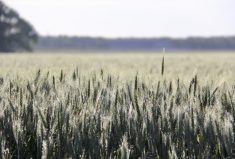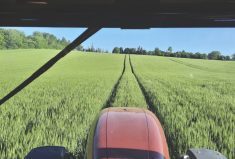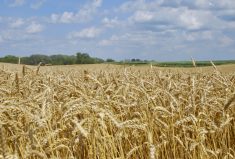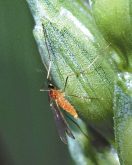A proposal by the Canadian Grain Commission (CGC) to add two grading factors to its list of parameters is stirring considerable debate, mostly among members of the western Canadian food value chain, but also in the east. The two factors revealed in a document published by the CGC late last year are falling number (FN) and deoxynivalenol (DON) levels, and their inclusion has sparked many concerns about procedures, costs and impacts on the farmer.
Read Also

Producers aren’t panicking over tariffs and trade threats
The influence of tariff and trade uncertainity on farm business decisions.
To be clear, these are proposals at this stage. Nothing has been implemented by the CGC nor is there a timeline for the commission to enact such changes. Instead, the commission has asked for public input and is in the process of evaluating what it’s heard. (For the original proposal, its specifications and goals, check the grainscanada.gc.ca website.)
There is an incorrect perception that this is a western Canadian issue, based on the notion that visual characteristics and the proposed changes will mainly affect the export market for Canadian grains. Added to that is the reality that the CGC is not involved in purchasing grain for domestic use, which is the common destination for eastern cereals. Yet depending on if or how these changes are implemented, they could encompass both eastern and western cereal production under the banner of traceability or sustainability.
Part of what makes these proposed changes such a challenge is the number of organizations, business and interests that would be affected. The ultimate impact would be on the quality of finished products, but there are three specific concerns for farmers and for many in the trade. They include the accuracy of tests, the time taken for testing, and, of course, who pays. Several stakeholders have characterized the concept as “just another excuse” for downgrading grains and decreasing payments to farmers.
Country Guide approached a number of organizations, including the Cereals Canada, Canadian Grain Commission, Western Canadian Wheat Growers and Western Grain Elevators Association. Three individuals representing the groups responded.
The CGC opted against participating.
Cam Dahl
Cereals Canada

The accuracy of tests, the time it takes to carry out a test, the infrastructure required and the cost involved are foremost questions for Cam Dahl. As president of Cereals Canada, he believes shippers and farmers share the goal of objective grading versus a reliance on visual factors. However, this goal can only be achieved if the new procedures are accurate and cost-effective and can be carried out in country facilities.
“The more you can move to objective measures, the more accurate the grading system,” says Dahl. “I think everybody would like to see that as much as possible, but the trade-off on the other side comes in three key questions, one of which is accuracy — because these kinds of tests have a margin of error surrounding them.
The second is time, where if it’s a laboratory test, it could take significant amounts of time. And the third is the cost. That cost can be subdivided under equipment, allotting space inside of facilities and the value of time taken: if producers could have the test done while they wait to unload, it’d be better and more time-efficient than waiting for results from the lab.
“It can be done on-site, but again, you’re making sure the grain is ground properly, and it’s that accuracy of the process,” says Dahl, noting the same concerns exist for testing DON. “DON is the issue — not the fusarium itself but the toxin. Yet some of the strip tests and the accuracy of those tests are sometimes in question.”
There is also some discrepancy in the claims by the CGC, specifically that falling number can be linked to sprouting and that DON can be linked to fusarium. There is a relation between the factors but it’s not a straight line. Falling number measures the alpha-amylase activity that reflects sprouting but it’s not a visual “tell.” The same applies to lab results indicating DON concentrations and the physical manifestation of kernel visual distinguishability (KVD).
“There’s a direct link to the functionality on the other side — what kind of bread will come out of that, where flour made from sprouted grain has very different functional qualities compared to flour made from grain that has not begun to sprout,” says Dahl.
On the DON side of the equation he adds that there is a relationship between the different species of the fungus and the toxin it produces. In the past, there was only one major species of fusarium in wheat, but recently, more species have been identified, with different species producing different levels of DON. Although there’s a relationship between fusarium and DON levels, the increase in forms of the fungus makes a visual determination much harder than 10 or 15 years ago.
One aspect that Dahl highlights is that this is more of an issue for both Eastern and Western Canada. He points to the DON situation in Ontario corn in late 2018 and a fusarium head blight infection which ruined the P.E.I. wheat crop in 2010. In spite of the proposal to add falling number and DON seemingly affecting only exports, Dahl has asked for clarification from the CGC.
“Some of my questions to the Grain Commission are, “how does this apply to Eastern Canada?” he says. “How does it apply to corn? Have those kinds of questions been considered when this was being put together?”
Jim Wickett
Western Canadian Wheat Growers

Working with proposed changes to grading factors can translate into a lot of speculation, and that’s troubling for Jim Wickett, chair of the Western Canadian Wheat Growers (WCWG). His primary concerns focus on including falling number and DON levels because they’re parameters that growers don’t deal with, and determining who will pay for the implementation and operation for such testing.
“There’s a lot of suspicion that this will be one more reason to downgrade, instead of trying to achieve the value that it’s really worth,” says Wickett, who also farms near Rosetown, Sask. “I don’t know where they’re headed with this — the entire grading process really needs to be examined.”
That’s a contention based on the current version of the Canada Grain Act and its visual grading parameters, which predate the invention of the automobile, according to Wickett. Compared to the technology that’s already in use on most farms, the grading methods need to be upgraded to the 20th century, if not the 21st.
As farm costs rise and commodity prices remain relatively low (even as corn, soybean and wheat prices begin to climb in 2019), it’s unreasonable for consumers to insist that associated costs for traceability and sustainability be borne by the farmer, he says.
There can be no sustainability (and the same should be true for traceability) without profitability for the farmer.
“That’s an issue that a lot of farmers have, where a regulator sets its own rates and benefits from the regulations that it puts out to make things mandatory to suit their own budget,” says Wickett. “In the U.S., once they have enough operating money saved up, they stop charging. But we’re still charging and we’re still accumulating a surplus, but we have bureaucrats and other groups looking at $130 million and asking, ‘How can we spend that?’ And that’s not right: we should simply cut the fees and move on.”
Another point Wickett makes refers to the difference between Western Canada, where there isn’t the relationship between farmers and the mills, and Eastern Canada. This, he adds, is definitely an export-related issue which makes it more of a challenge for western Canadian growers. Yet the piece-meal approach of just adding more parameters to an outdated process will not make Canadian grains more competitive.
What’s more frustrating for Wickett and others is that the Grain Commission had technology which made a so-called “driveway test” economically feasible. It was eight to 10 years ago that the commission tested the Read-Rite machine and although it was shelved, the blueprint for it exists, with the potential for augmenting the system with sensors now available.
Instead, the CGC is proposing to add two factors to the grading system without justifying costs or the process of conducting the tests. There’s also no guarantee that any two tests conducted with the same methods or equipment will yield the same results.
“In my time on the Western Standards Committee six or seven years ago, they were testing those Read-Rite machines and we talked about DON and falling numbers,” recalls Wickett. “One of the scientists for the commission kept mentioning that if two different people are testing the same sample of wheat, they can get a different number. If there’s a different source of water than the elevator down the road, you can get a different number. There are all kinds of variables.”
Wade Sobkowich
Western Grain Elevator Association

The concept behind adding falling number and DON levels is a noble goal, improving and ensuring grain quality, says Wade Sobkowich of the Western Grain Elevator Association (WGEA), but it’s not a practical approach. Any failing in that chase can be costly to those who can least afford it.
There is an “order of operations,” Sobkowich adds, that needs to be respected when considering the introduction of new factors.
“This includes the determination that the technology exists to produce repeatable, accurate, timely and cost-effective test results upon delivery to an elevator,” says Sobkowich. “To date, we are not aware of technology that would meet an acceptable threshold in each of these categories.”
The WGEA response to the CGC proposal is a seven-page write-up including several clarifications on statements made by the commission in its outline, as well as the association’s position opposing changes without due consideration.
Sobkowich emphasizes that added costs to the system to support DON and falling number factors would likely be borne by growers. He also cites the impact of something like the basis and the effects of tying-in falling number and DON tests, with “Company A” involved in grain exporting and investing in an on-site laboratory, while “Company B” sends the sample to a lab for testing. The on-site sampling would provide results at the time of delivery with added costs; the off-site testing would result in lower added costs but a better price to the farmer than the other company.
“Since it’s a competitive environment, Company A will only be able to pass as much of their costs to the farmer as the producers will bear before they make the decision that the risk of deferred settlement is acceptable for a potentially greater return,” says Sobkowich. At that point, they’ll choose to do business with Company B. “Company A still needs the grain, so they’ll have to narrow their basis and absorb a portion of these costs to attract the grain.”
Also part of the WGEA’s opposition is the fact that wheat buyers from outside Canada already purchase wheat based on the specifications they require.
If they already need certain minimum falling numbers and DON levels, those would be specified in the sales contract. As a result, Sobkowich says making falling number and DON part of the grade will have no impact on sales contracts, nor will it help increase wheat exports from Canada — and it would be invisible to the customer.
“Most customers want to know the class of wheat, like is it CWRS, the grade — number one or two — plus a number of other quality specifications such as protein, falling number and DON,” says Sobkowich. “The move is to try to reflect how customers already buy back to the farm level. However, we cannot accurately, reliably and cost-effectively measure falling number and DON in a timely way.”
















